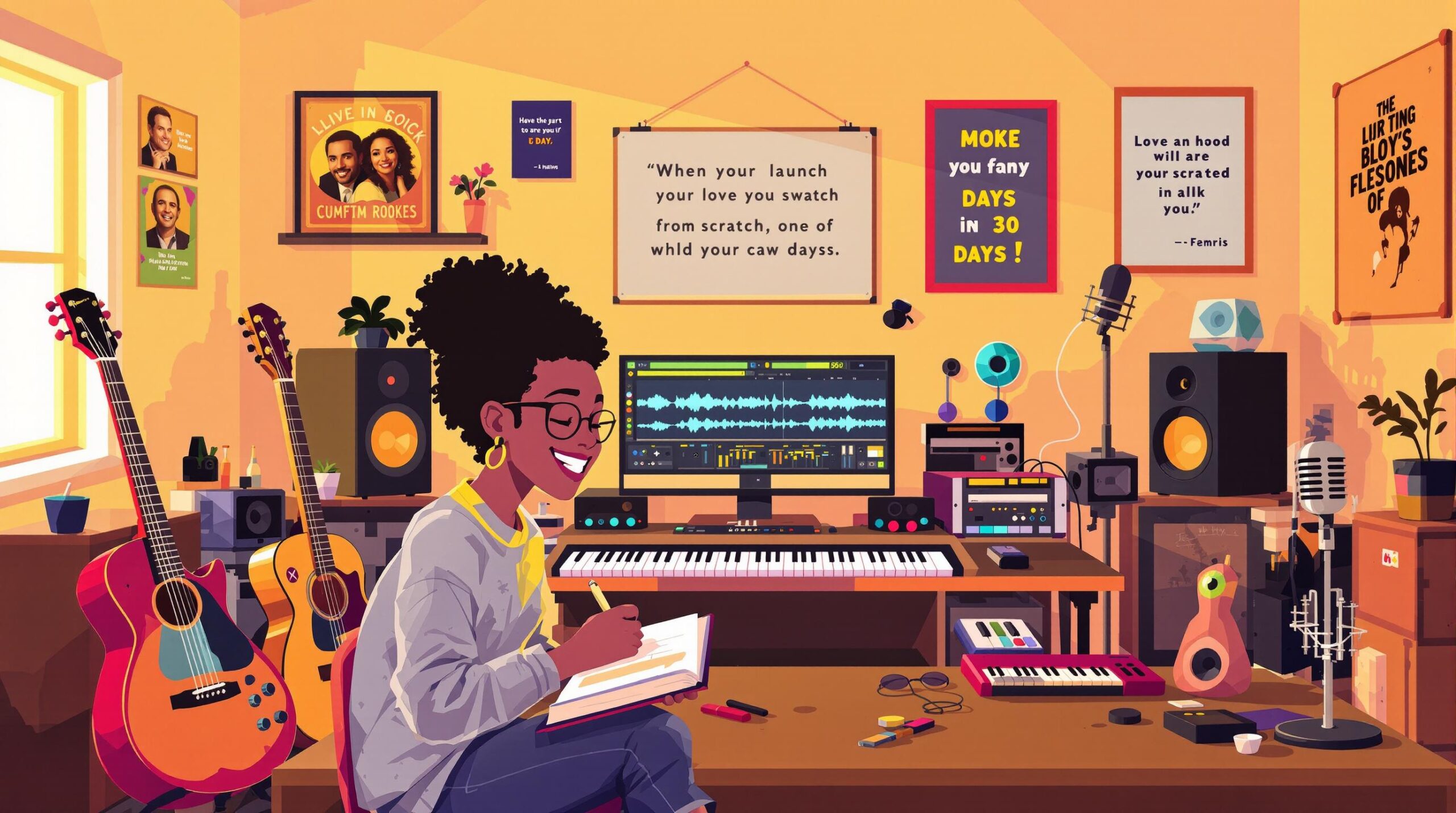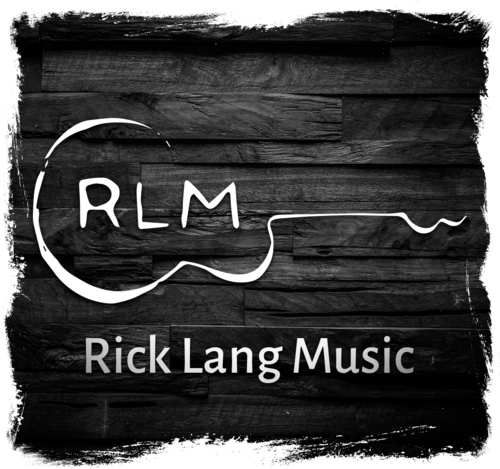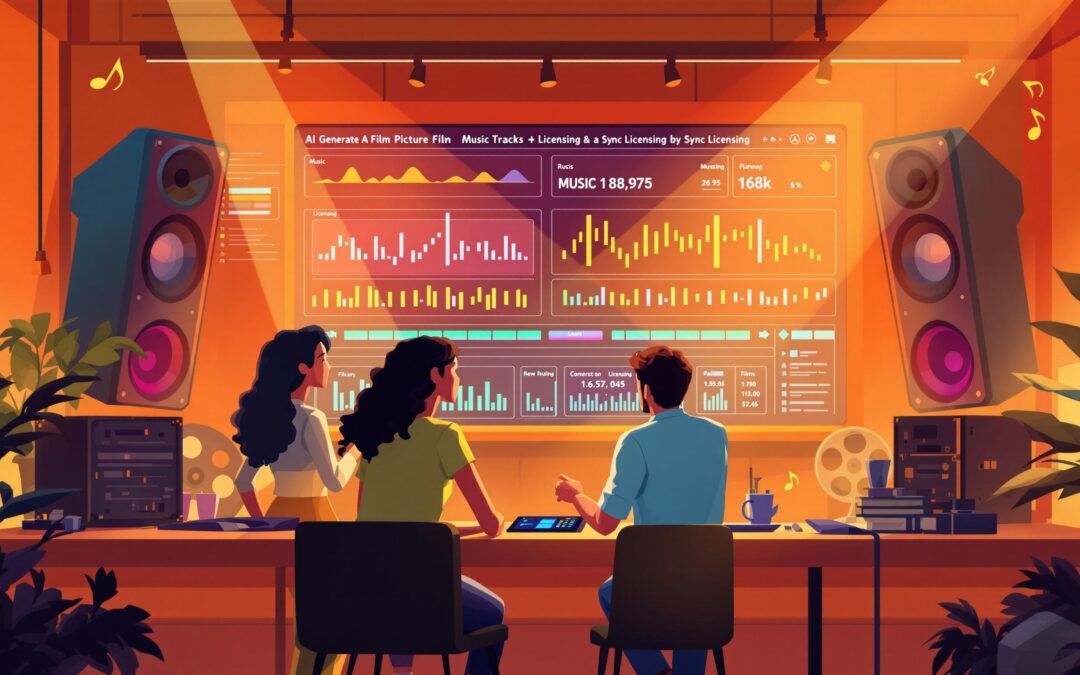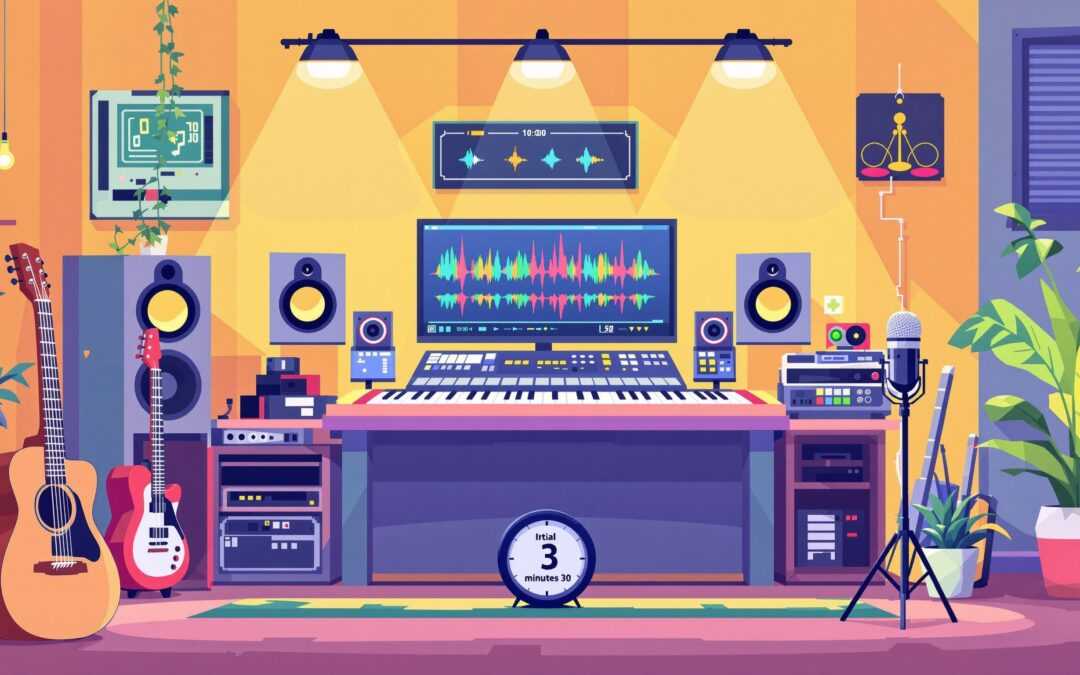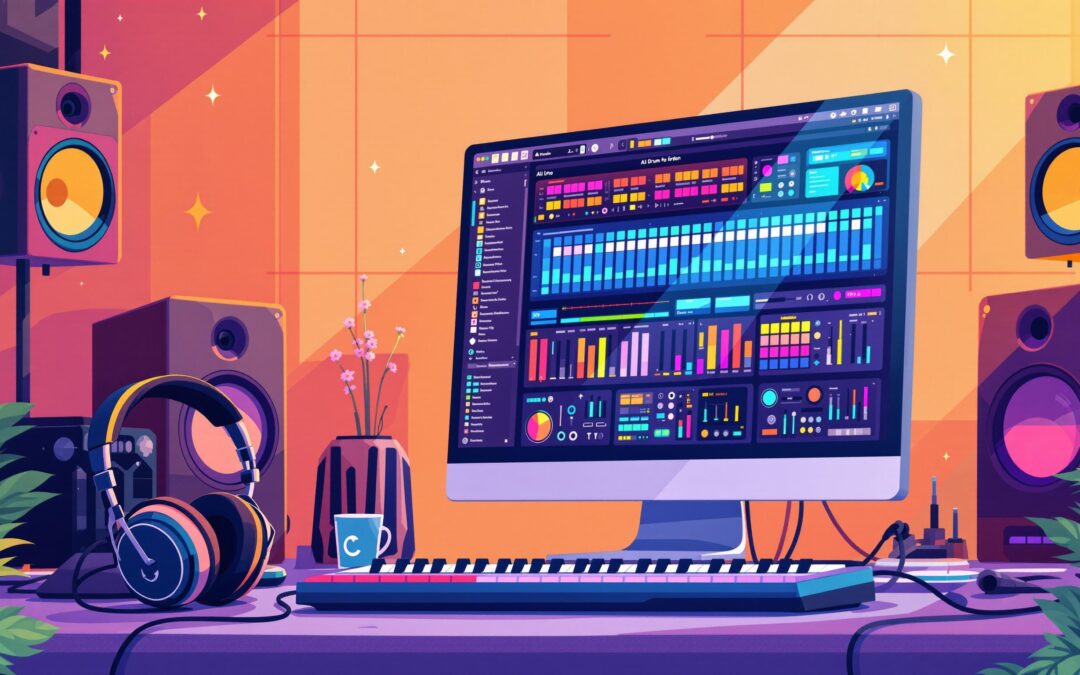Want to write, record, and release a song in just 30 days? Here’s a simple, step-by-step plan to go from idea to release-ready track in one month.
Key steps include:
- Week 1: Write your song – brainstorm ideas, craft lyrics, and create melodies.
- Week 2: Set up your home studio and record vocals.
- Week 3: Mix your song – arrange tracks, balance audio, and add effects.
- Week 4: Prepare for release – master your track, design artwork, and publish it on platforms like Spotify or Bandcamp.
Tools you’ll need: Basic gear like a microphone and free software (e.g., GarageBand or Cakewalk). Follow this plan to stay consistent and create a song you’re proud of!
How To Record A Song From Scratch – Getting Started
Week 1: Writing Your Song
Turn your musical ideas into a complete song with simple, daily steps.
Days 1-3: Finding Your Song Idea
Kickstart your creativity with these songwriting exercises.
"Songwriting is an incredible journey of self-expression, storytelling, and creativity"
- Stream-of-Consciousness Writing: Spend 5 minutes writing without overthinking. This helps break creative blocks and unlock raw emotions that can shape your song.
- Sensory Exploration: Look around and list five things you can see, hear, touch, smell, and taste. These sensory details can inspire vivid and relatable lyrics.
Use these exercises to lay the groundwork for lyrics that feel personal and real.
Days 4-5: Writing Your Lyrics
Now that you have your idea, focus on writing lyrics that stand out.
"The more detailed your lyrics are, the more widely relatable your song will be"
Here are some examples of how specific details can elevate your lyrics:
| Instead of Writing | Write This Instead |
|---|---|
| "I’m angry at you" | "Smash all the pictures where I am in the frame" (Bruno Major) |
| "I miss you" | "Water’s getting rough, swimming in your stuff" (JP Cooper) |
| "I want to help" | "We can even sing songs about your past loves at my piano" (Luca Fogale) |
Detailed lyrics make your song more relatable and memorable.
Days 6-7: Building Melody and Chords
With your lyrics complete, it’s time to create a melody that sticks.
"When I use the word effective for a melody, I mean a melody that is easy to remember. Because as composers, that’s what we want, right? People to remember what we wrote"
Key Selection Guide:
| Key | Emotional Quality |
|---|---|
| C Major | Happy, pure |
| A Minor | Tender sadness |
| F Major | Energetic |
| G Major | Balanced |
"There are no rules. There are guidelines. It’s called music theory. It’s no substitute for the real, live sound of music"
To craft your melody:
- Start with a simple chord progression.
- Double the root notes an octave higher.
- Add passing notes between chord tones.
- Play around with rhythm to find what fits.
Use familiar patterns with slight twists to keep your listeners engaged.
Week 2: Setting Up and Recording
With your song ready, it’s time to create a simple and effective recording setup.
Days 8-10: Home Studio Basics
Set up your home studio with affordable gear that delivers great results. Here’s a quick guide to essential equipment:
| Equipment Type | Budget Option | Pro Option | Key Feature |
|---|---|---|---|
| Audio Interface | Behringer UMC22 ($50) | Focusrite Scarlett 2i2 ($160) | Clean preamps |
| Studio Monitors | PreSonus Eris E3.5 ($99/pair) | JBL 305p MkII ($300/pair) | Accurate sound |
| Headphones | AKG K240s ($69) | – | Flat response |
| Microphone | Shure SM57 ($99) | Rode NT1-A ($229) | Versatility |
Place your monitors at ear level, forming an equilateral triangle with your head. For acoustic treatment, heavy blankets can help reduce unwanted room noise.
Days 11-13: Using Your DAW
Choose a DAW (Digital Audio Workstation) that suits your budget and workflow. Here are some popular options:
Free/Budget DAWs
- GarageBand (Mac only): Perfect for beginners.
- Reaper ($60): Packed with pro-level features at a low cost.
- Cakewalk by BandLab (PC): A free, full-featured option.
Professional DAWs
- Logic Pro ($199): A favorite for Mac users.
- Ableton Live Intro ($99): Ideal for electronic music production.
- FL Studio (starting at $99): Great for beat-making.
Once you’re comfortable with your DAW, you’re ready to record clean, polished vocals.
Day 14: Recording Vocals
Follow these steps to capture high-quality vocal recordings:
- Mic Setup: Position the microphone 5–8 inches from your mouth, angled slightly downward with a pop filter in place. Use the quietest room you can find, and add basic acoustic treatment for better sound.
- Recording Levels: Adjust levels so the average signal is around –18 dBFS, with peaks hitting about –10 dBFS. This ensures enough headroom for mixing.
"Getting a good headphone mix is vital to enabling a great vocal performance." – Brian Fisher
Pro Tips
- Start with verses while your voice is fresh.
- Take breaks every 30–45 minutes to avoid straining your voice.
- Keep detailed notes of your best takes to streamline editing later.
- Use light compression during recording – aim for a reduction of 2–3 dB for smoother dynamics.
sbb-itb-1c6af30
Week 3: Mixing Your Song
Days 15-17: Track Arrangement
Organize your tracks with a clear color-coding system – think red for the kick, brown for the bass, and blue for the melody. Break your song into sections like intro, verse, chorus, bridge, and outro, and mark transitions between them. Assign key elements to each section and bring in new sounds during transitions to keep things interesting. Add effects like risers or drum fills to make the transitions feel smooth. A well-structured arrangement lays the groundwork for a polished mix.
Days 18-20: Basic Mixing Steps
Start by muting all your channels. Gradually bring in the core tracks – like vocals or drums – one at a time. Aim to have them peak between –12 dB and –6 dB for a balanced sound. Pan your elements across the stereo field, keeping bass and vocals centered. Use EQ to clean up problem frequencies and create space for each instrument. Add compression to manage dynamics and give certain elements more punch.
Day 21: Adding Effects
Finish off your mix with reverb and delay to add depth. Begin with the vocals and experiment with options like blend delays, ping-pong effects, or ducking delays. You can use free plugins such as Cockos’s ReaDelay or Voxengo’s Tempo Delay to achieve the sound you’re looking for.
Week 4: Release Preparation
Days 22-24: Song Mastering
Get your track ready for playback on all devices. Start by exporting your final mix as a WAV file with 3dB headroom to avoid clipping. Use a reference track to match loudness levels and overall sound quality.
Tweak your mix with subtle EQ adjustments (±3dB) and light compression to create a cohesive sound. Add a touch of saturation for warmth and slightly widen the stereo field for mid and high frequencies, keeping the bass centered in mono.
Set the limiter ceiling between -0.3dB and -0.5dB for streaming platforms. Export the final master as a 16-bit, 44.1kHz WAV file with dither applied. Test your track on multiple systems – car speakers, headphones, and phones – to ensure it sounds great everywhere.
If you’re on a budget, AI mastering tools like Soundtrap can help. For a professional touch, mastering engineers typically charge between $50 and $500 per track.
Days 25-27: Cover Art and Song Info
Your song’s visuals are just as important as the audio. Create a high-resolution square image (e.g., 4000×4000 pixels) using tools like GIMP or online platforms such as Adobe Spark. Make sure any text on the cover is clear and readable, even at smaller sizes. If you’re using stock images, combine elements to make the design stand out.
| Tool Type | Free Options | Paid Options |
|---|---|---|
| Image Editing | GIMP | Adobe Photoshop |
| Stock Photos | Unsplash, Pixabay | – |
| Fonts | Google Fonts, 1001 Free Fonts | – |
| Online Creators | – | Adobe Spark |
Days 28-30: Publishing Your Song
Now that your mastering and artwork are done, it’s time to publish. If you’re using Spotify, claim your artist profile and work with a distributor that supports high-resolution audio and artwork requirements.
For Bandcamp, take advantage of tagging and page customization features. Offering merchandise can help increase revenue, and Bandcamp’s community features can contribute up to 30% of monthly sales. The platform also lets you set custom pricing for your music.
Make sure your metadata is accurate. Include details like the song title, artist name, genre tags, and release date. Plan your release timing carefully and coordinate it with announcements on your social media channels.
Conclusion: Next Steps After Release
You’ve completed your 30-day song creation journey – well done! Now, it’s time to focus on getting your music heard and planning future releases in a market where 24,000 new songs are released daily. One effective approach is the "Waterfall Strategy", which involves dropping a new single every 3–4 weeks to keep up the momentum. As Charli XCX says: "When you’re sitting there with a really good song, you can keep it moving without waiting on a record label". This strategy can help you stay consistent and ahead of the curve.
Timing matters, too. Fridays are the best days for releases since 95% of major debuts happen then. Pair that with promotional pushes on Mondays to align with peak streaming days. To stay relevant in streaming algorithms, aim to release new tracks at least every quarter.
Tracking your song’s performance is just as important. Platforms like Songstats can help you monitor key metrics, such as listener growth, playlist additions, and saves. These insights will guide your future decisions.
Building on the discipline you developed during the past month, create a release plan that keeps your audience engaged. Industry expert Liz Eason advises:
"Space out the coverage, rather than all within the first week. Schedule out highlights or wins every week, so you have one a week."
Keep your fans connected by sharing behind-the-scenes content and documenting your creative process. This not only promotes your music but also strengthens your connection with listeners.
"It’s not just about getting your music out there, but about connecting with fans, building a community, and sharing your unique sound and story."
Use the foundation you’ve built to craft a release schedule that works for you. Refine your workflow, stay true to your brand, and keep creating.
